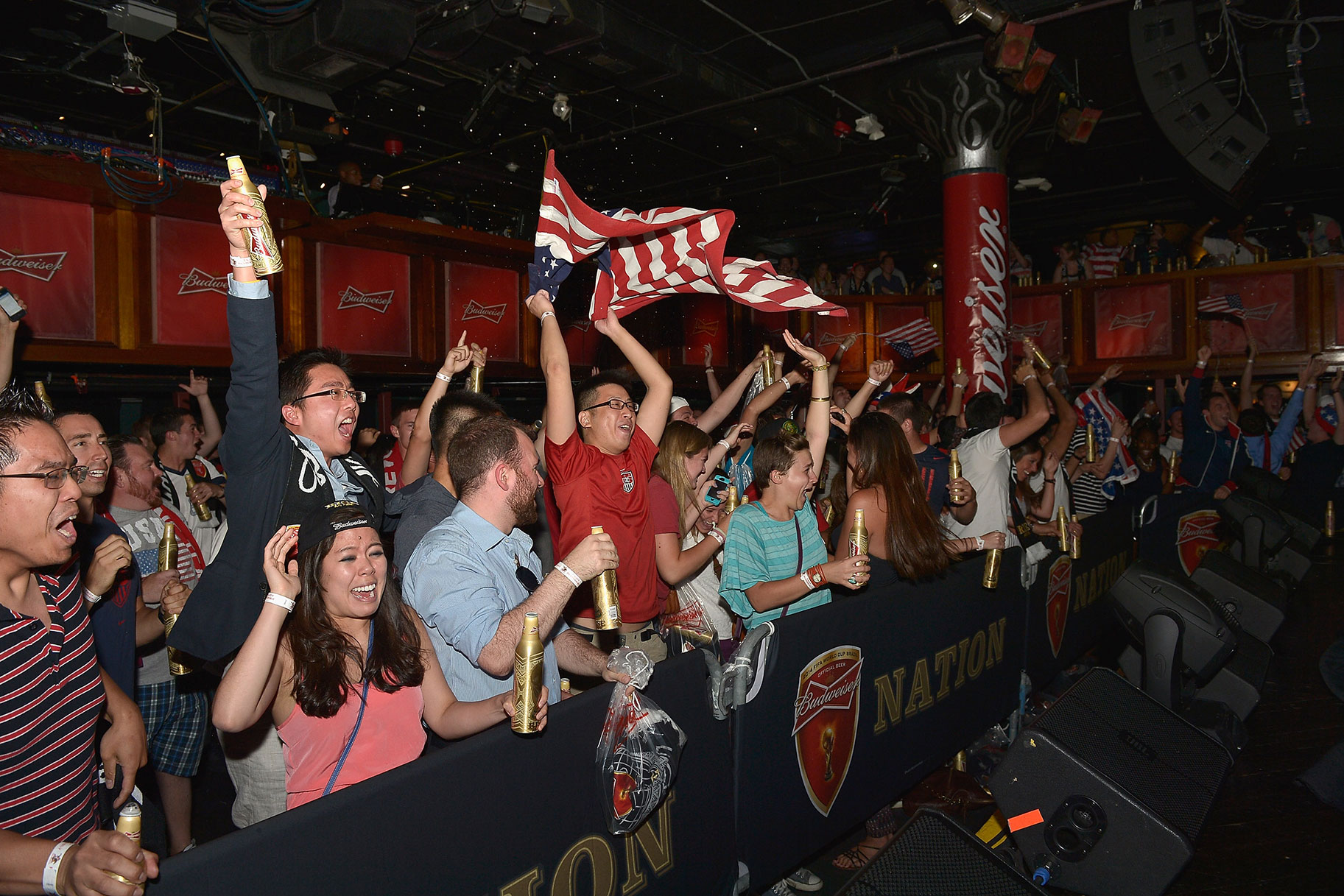How Not to Feel Like An Idiot At A World Cup Watch Party
With the FIFA World Cup in full swing, you definitely don't want to look like a fool in front of your soccer-loving friends. We're here to help.

There’s nothing worse than being invited to a boozy World Cup viewing party only to find yourself wondering what the hell a goatee-less Alexi Lalas is pontificating about while your bleary-eyed mates excitedly jump around like a toddler eating cake for the first time. We get it. You have to save face, right? The 2022 FIFA World Cup in Qatar is a big deal, and with it, comes the responsibility to shed your soccer ignorance and display at least a modicum of knowledge about the sport, no matter which team your friends coerce you into rooting for (let’s go USMNT!) So, while this won’t turn footy fools into soccer savants, we’ve got you covered in our crash course on basic World Cup rules.
What’s Offside?
Simply put, this rule exists to stop a team's attackers from hanging around behind the opposing team's defenders, allowing them quickly strike against the opposition goalie. The rule states that a player is deemed offsides if he’s in his opponent’s half of the field, and any part of his body is closer to his opponent’s goal than both the ball and the second-last opponent, which is usually a defender. A typical example to watch out for is when one team is pressing on attack, turns the ball over in the defending team’s half, and the defense counters with a long ball over the top or past opposing defenders to a forward looking to make a breakaway run at his opponent’s goal. If that forward is too impatient and doesn’t stay in front of his opponent’s defense as the ball is played, chances are, he'll be whistled for offside. One of the line referees will signal an offside call by raising a flag. Since a tenth of a second could be the difference in an offside call, attacking players must be very careful to time their runs accordingly, as there’s nothing worse than having a goal waved off due to offside.
What Does a Yellow Card Mean?
Does that mean you’ve been a naughty boy, and now you’ve been warned about your cheekiness? Essentially, yes. A ref will usually raise a yellow card when a player commits a hard foul on his opponent, such as a late tackle, where a defender slides into his opponent who has the ball, but instead of touching the ball first, hits his opponent’s foot or leg, thereby disrupting the attacking player’s ability to advance the ball. Another example of a yellow card infraction is when a defending player blatantly pulls on the jersey of the ball carrier, preventing him from launching an attack. A player could also get a yellow card for excessive fouling, or giving the referee too much lip. If a player picks up two yellow cards, that equates to a red card, and that player will be ejected for the game as well as suspended for the following match. It's also worth noting that yellow cards also accumulate through the tournament. So if a player picks up a yellow in their team's first game, then another yellow in the team's third game, then they'll be suspended for their team's fourth game (if they make it that far). Thankfully, every player's slate is wiped clean after the quarterfinals. Still with us, or is that smoke coming out of your ears?
RELATED: Who’s Going To The World Cup: 8 Of The Biggest Stars To Follow
What’s a Corner Kick?
Ready for another brain-buster, Billy? Well, you can relax your cerebral cortex for now because this is a fairly easy one. A corner kick takes place when a defending team's player sends the ball, intentionally or otherwise, out of bounds behind his team's end line. The attacking team then gets to kick the ball from the end line corner closest to where the ball went out of bounds. This allows the attacking team to load players around their opponent's goal and try to deflect the corner kick in for a goal. In low-scoring games, corner kicks can prove crucial opportunities to get that decisive goal. Easy peasy, lemon squeezy.
What’s a Throw-In?
When a team knocks the ball out of bounds on the sideline, the opposing squad is rewarded with a throw-in. While you can’t take a crow hop and hurl a Tom Brady Hail Mary, long distance throw-ins can still penetrate deep into the defense to set up a potential goal. To execute a proper throw-in, a player holds the ball with two hands and throws the ball over his head while keeping both feet touching the ground.
Why Doesn’t the Clock Stop, and What’s Stoppage Time?
Try not to overthink this one. In soccer, the time on the clock counts up rather than down, like in all other U.S. sports. The reason for a running clock is to simplify timekeeping so the sport can be universally played anywhere in the world with a single referee keeping time on a simple stopwatch. Similarly, stoppage time refers to the additional time added at the end of both halves to account for the pauses in play caused by penalties, free kicks, balls out of play, injuries on the field, etc. – essentially, all those moments where there’s no active play add up in each half, equating to usually a few minutes of stoppage time each half. See, wasn’t that simple?
What Are the Substitution Rules?
First off, a substitute is a player brought into the game off the bench, replacing a teammate. But there are restrictions: a player who is removed for a sub can't re-enter the game (like they can in basketball, for example). Teams also have a limited number of substitutes in each game. In previous World Cups, teams were only allowed three subs, but due to the ongoing impact of COVID, and the fact that the tournament is taking place in the middle of the major European leagues' seasons, FIFA expanded that rule to allow for up to five subs in this year’s tournament in Qatar. However, a team will only be able to make substitutions within three windows. For instance, if a team makes one sub in the 50th minute, then one other sub in the 60th minute, they'll have only one window left to make use of their final three subs. If they foolishly decide to make only one substitution at the 70th minute, then they're out of luck – those additional two subs will have been wasted. For this reason, teams will often make multiple substitutions within the same window, so as not to waste the opportunity to inject some much-needed energy into the squad. It's also worth noting that if the game goes into "extra time," or overtime, then each team will receive one additional sub. Fresh legs can make or break a tight match, so be aware of how a coach strategically decides to use those substitutions late in the game.
Care to explain "Extra Time" a bit more?
Sure. So a normal soccer match is 90 minutes long, split into two 45-minute halves (barring stoppage time, which we explained a bit further up.) During the group stage, if the two teams are tied at the end of the 90 minutes, then each get one point. But what about during the knockout rounds, where there has to be a winner? That's where extra time comes in. If two teams are tied at the end of regulation in the knockout rounds, then they'll play an additional 30 minutes of "extra time" that are split into two 15-minute halves. Extra time will begin almost immediately after the end of regulation (save for a TV commercial break) and there's virtually no break between the two halves (again, except for an ad break). It's not a sudden-death scenario either. The full 30 minutes will be played regardless, meaning viewers could be treated to multiple goals by two increasingly exhausted and mistake-prone squads. If the game is still tied after extra time, then the game will be determined by penalty kicks, with each side sending their five best penalty takers up to take alternating attempts against the opposition keeper from the penalty spot, 12 yards from the goal.
What’s VAR?
While this sounds like the latest iteration of a malfunctioning robot from an evil genius, in reality, VAR’s far from the sinister harbinger of doom it sounds like. Defined as video assistant referee, VAR is a qualified match official who will assist the on-field referee only in the event of a “clear and obvious error” or a “serious missed incident” in relation to either a goal/no goal, penalty/no penalty, or potential red card incidents. With independent access to match footage, VAR reviews as many angles as possible before it makes its recommendation, but the final decision is always left to the on-field referee. So, relax, John Connor, Skynet has nothing to do with VAR. … For now.
Now that you’re equipped with all the knowledge a footy novice could ever hope for, pass it along to that dude standing shyly in the corner, sipping rosé (that should be a red card at any viewing party!), and always remember the cardinal rule of any good World Cup viewing party: friends don’t let friends looks stupid while watching soccer.
Feeling the pull of soccer? You can watch Premier League coverage on USA Network, featuring Premier League Mornings, select matches, and Premier League Goal Zone (check listings for games/schedule). And catch up on all the action on Peacock.















